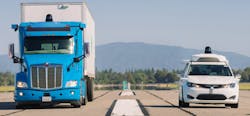Waymo is now the name of Google’s self-driving car project. Its stated mission is to make it safe and easy for people and things to move around. So far, the focus has mostly been on people; last fall it put the world’s first fleet of fully self-driving cars on public roads in the Phoenix area.
Now Waymo is turning its attention to things as well. Starting next week, it will launch a pilot in Atlanta where its self-driving trucks will carry freight bound for Google’s data centers. Fig. 1 shows Waymo’s self-driving truck and car side-by-side.
1. Waymo’s self-driving semi is shown alongside its automobile cousin.
Over the past year, Waymo has been conducting road tests of its self-driving trucks in California and Arizona. Its software is learning to drive big rigs in much the same way a human driver would after years of driving passenger cars. The principles are the same, but things like braking, turning, and blind spots are different with a fully-loaded truck and trailer.
Now Waymo is headed to Georgia. Atlanta is one of the biggest logistics hubs in the country, making it a natural home for Google’s logistical operations and the perfect environment for the next phase of testing Waymo’s self-driving trucks.
This pilot, in partnership with Google’s logistics team, will let Waymo further develop its technology and integrate it into the operations of shippers and carriers, replete with their network of factories, distribution centers, ports and terminals. As these self-driving trucks hit the highways in the region, they will have highly-trained drivers in the cabs to monitor systems and take control, if needed.
Waymo has made rapid progress because its driver — Waymo’s self-driving technology — is not only experienced, but adaptable. The self-driving trucks use the same suite of custom-built sensors that power Waymo’s self-driving minivan. They benefit from the same advanced self-driving software that has enabled its cars to go fully driverless in Arizona. And Waymo’s engineers and AI experts are leveraging the same five million miles it’s already self-driven on public roads, plus the five billion miles it’s driven in simulation. In short, this near-decade of experience with passenger vehicles has given it a head start in trucking.
Trucking is a vital part of the American economy, and Waymo believes self-driving technology has the potential to make this sector safer and even stronger. With it in the driver’s seat, it can reimagine many different types of transportation — from ride-hailing to logistics. So if you’re in the Atlanta area, look for a bright blue Waymo truck making a run!
Tesla Semi on the Move
Tesla unveiled its all-electric semi in November 2017 (Fig. 2). Now Tesla Semi is putting the truck’s characteristics to the test with a production model rolling out of its Nevada Gigafactory, with batteries onboard for the very first time. The production model Tesla Semi has started hauling battery packs along the 260-mi route to California.
2. Tesla’s semi is said to have a 500-mile range on a single charge.
When it was introduced Tesla said the truck could accelerate to 97 km/h (60 mph) in five seconds flat when empty. When fully loaded to its capacity of 80,000 lb., Tesla claimed it would only take 20 seconds. Range was listed at 500 mi on a single charge, while fully loaded and traveling 65 mph.
It’s not clear whether Tesla’s truck will be self-driving in a manner similar to its cars, which do not yet have full self-driving capability.
About the Author

Sam Davis
Sam Davis was the editor-in-chief of Power Electronics Technology magazine and website that is now part of Electronic Design. He has 18 years experience in electronic engineering design and management, six years in public relations and 25 years as a trade press editor. He holds a BSEE from Case-Western Reserve University, and did graduate work at the same school and UCLA. Sam was the editor for PCIM, the predecessor to Power Electronics Technology, from 1984 to 2004. His engineering experience includes circuit and system design for Litton Systems, Bunker-Ramo, Rocketdyne, and Clevite Corporation.. Design tasks included analog circuits, display systems, power supplies, underwater ordnance systems, and test systems. He also served as a program manager for a Litton Systems Navy program.
Sam is the author of Computer Data Displays, a book published by Prentice-Hall in the U.S. and Japan in 1969. He is also a recipient of the Jesse Neal Award for trade press editorial excellence, and has one patent for naval ship construction that simplifies electronic system integration.
You can also check out his Power Electronics blog.



